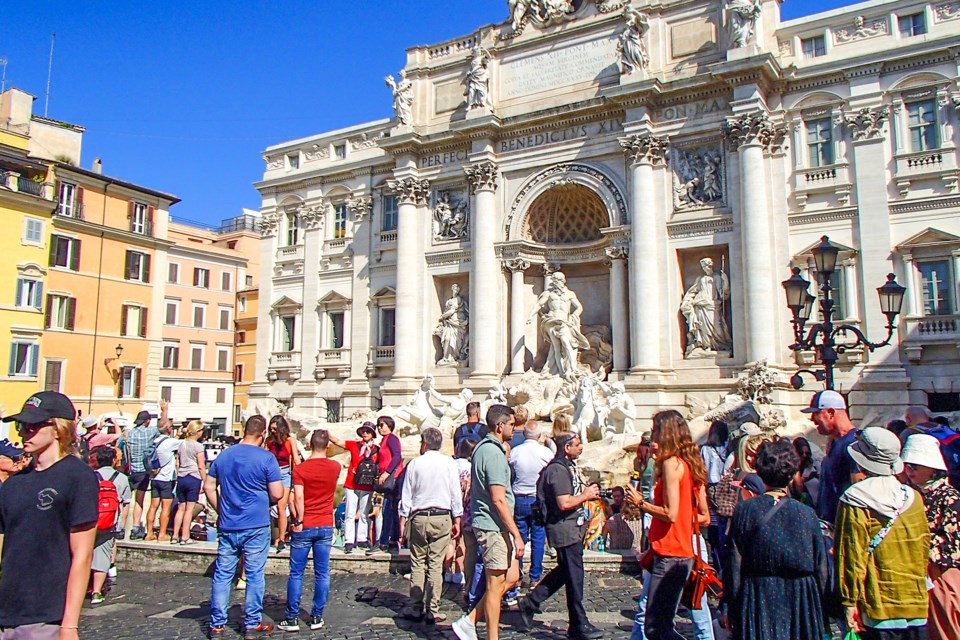I recently returned from a three-week European holiday, which commenced in Rome, a city I first visited a decade ago. We’re into the peak season for travellers, and the major attractions — the Colosseum, Pantheon, Trevi Fountain, Spanish Steps, plus the Vatican with St. Peter’s Basilica and Michelangelo’s Sistine Chapel — were heavily congested, with a sea of humanity intent on taking selfies at every opportunity. The Pantheon alone sees 35,000 to 40,00 tourists a day, and lineups for attractions snaked out of sight. Those claustrophobic around large crowds would not fare well here.
My previous impressions of Rome had been almost entirely positive, but I had a hard time reconciling those memories with the conflicting images now before my eyes.
Tourism is thriving in Rome, rebounding since the pandemic, with seven to ten million visitors descending on the city each year to view its ancient ruins and panoramic landscapes, and soak in its culture and history. But the Eternal City’s infrastructure and urban core are crumbling due to years of political mismanagement, corruption, and neglect. A lack of urban decorum has resulted in low numbers of repeat visitors, a problem not experienced by other European Union tourist meccas like London and Paris.
Two millennia ago, Rome was the centre of Western civilization, ruling all of the Mediterranean, Northern Africa, parts of the British Isles and Europe, and a chunk of the Middle East. One of the oldest cities on the continent, and currently home to some three million people, its architectural beauty is extraordinary. But graffiti is ubiquitous in the city’s core, which correlates with youth unemployment hovering around 28 percent currently, according to Statistica (it was over 40 percent less than a decade ago). A whiff of septic and uncollected garbage regularly wafts through the air, and Rome’s greenery is often unkempt. Temperatures routinely exceed 30 C during the tourist season. Pedestrians beware: the city’s cobblestone streets are uneven and treacherous, and laden with potholes. Sensible shoes are a must when exploring Rome on foot.
Tourism is Italy’s oil, and it provides much-needed employment for its citizens as tour guides, restaurant waiters and cooks, cleaners, and in other service roles. However, local citizens, though cognizant of the city’s dependence on post-pandemic revenue based on tourist dollars, have grown weary of the crowding, disruption, and noise that are a consequence of hordes of foreign visitors (heavily skewed towards Americans). Everyday Romans especially detest the intrusion of tens of thousands of Airbnbs which have clotted their neighbourhoods. Small businesses offering services to the residents have been replaced by a proliferation of pizza and gelato shops, geared to the budgets and fast-food tastes of tourists. As costs have risen, many Romans have simply been priced-out of the city centre, and have relocated to cheaper parts of Rome.
Rome is still relatively cheap compared with other European cities, although the local government’s tourist levy – which varies from €4 to €7 a night, depending on the elegance of accommodation – is the highest in Europe, and visitors routinely question the cash grab in a city where services for tourists are pretty much non-existent.
Aside from the ever-present pickpockets, Rome has a reputation of being quite safe. Public transportation, like most of its infrastructure, is not great, so be prepared to fork out some Euros for a taxi or Uber. Italian food is fantastic, and authentic restaurants in rural neighbourhoods still offer up culinary delights at reasonable prices. Did I mention the wine is excellent?
Walking the narrow side streets and more spacious boulevards, one can’t help but notice the stark contrast between the tourists garbed in their casual T-shirts, shorts, and sandals, and the locals, whose dress is decidedly more stylish and elegant.
Traffic is frenetic in the downtown core, as the locals in their tiny Fiats and omnipresent taxis jockey for space with the infuriatingly plodding, open-top tour buses. Mopeds and motorcycles zip in and out of lanes (and routinely skirt between vehicles) seemingly unaware of the peril. Renting a car would be an exercise in insanity.
I suppose one could overlook the peeling facades and graffiti, the odorous sewers and discarded rubbish, if the decay is viewed within the context of being part-and-parcel of the historic grandeur of this iconic city on the banks of the Tiber River, founded by Romulus and Remus in 753 BC.
Never been to Rome? By all means, go. Once. The city is steeped in a rich history which must be seen firsthand. But I doubt I’ll be back. Now, Venice — which I also visited on my holiday excursion — that’s potentially a different story. I’ll cover the “Floating City” (also known as "La Serenissima", "Queen of the Adriatic,” and "City of Canals”) in a following article.



